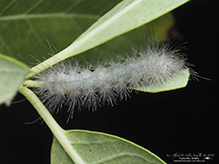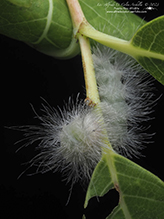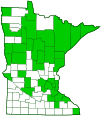delicate cycnia
(Cycnia tenera)
Conservation • Description • Habitat • Ecology • Distribution • Taxonomy
|
||||||||
| Hodges # | 8230 |
|||||||
Conservation Status |
||||||||
| IUCN Red List | not listed |
|||||||
| NatureServe | N5 - Secure SNR - Unranked |
|||||||
| Minnesota | not listed |
|||||||
Description |
||
Delicate cycnia, also called dogbane tiger moth, is a common, easily recognized, medium-sized moth. It occurs across the United States and southern Canada. In the U.S. there are two widely separated populations. In the east, it occurs from Maine to Georgia, west to Minnesota and eastern Oklahoma. In the west, it occurs from Washington to western Montana. Between these areas there are widely scattered records. There are historical records from the southwest, but it is now presumed extirpated from there. Delicate cycnia is common in Minnesota. The larvae are food specialists. They feed on the leaves of dogbanes and milkweeds. Adults are found in a wide variety of open areas, including meadows, old fields, and roadsides, wherever their host plant is found. They are active from May to October in other parts of their range. In Minnesota, almost all records of adult delicate cycnia moths, both historical and modern, are from the months of June and July. The only exception was a sighting on August 14, 2018, in Washington County. This suggests that there may be just a single generation per year in Minnesota. Adults are ⅝″ to ⅞″ (16 to 22 mm) in length and have a 1 3⁄16″ to 1 9⁄16″ (30 to 40 mm) wingspan. Moth size is sometimes given in terms of forewing length, which for this moth is ½″ to ¾″ (13 to 19 mm). The head is orangish yellow. The antennae are whitish above and dark below. On the male they are feather-like, with short branches on both sides (bipectinate) from the base to the tip. On the female, they are unbranched (simple). On the thorax, the upper side of the first segment (collar) is orangish yellow. There is a pair of densely hair-covered, scale-like plates (patagia) that cover the wing bases. The patagia are orangish yellow, at least at the base. The rest of the thorax is white. The upper side of the abdomen is white. On each segment there is a narrow yellow band on the rear margin and a large black spot in the middle. The forewings are long, broad, creamy white, and somewhat translucent. They are unmarked except for an orangish-yellow stripe on the leading edge (costal margin), The stripe extends beyond the midpoint of the wing but fades before reaching the wingtip. The veins appear whiter only because they are opaque. The hindwings are similar to the forewings, but the stripe on the costal margin is paler. The legs are bicolored, dark on the sides and below, whitish above. The caterpillar is densely covered with long, soft, gray hairs. |
||
Size |
||
Total length: ⅝″ to ⅞″ (16 to 22 mm) Wingspan: 1 3⁄16″ to 1 9⁄16″ (30 to 40 mm) |
||
Similar Species |
||
Unexpected cycnia moth (Cycnia collaris) wings tend to be darker. The stripe on the costal margin may be orangish yellow or gray, and it does not extend beyond the midpoint of the wing. |
||
Habitat |
||
Open areas, including meadows, old fields, and roadsides, where their host plant is found |
||
Ecology |
||
Season |
||
One or two generations per year in Minnesota: June and July |
||
Behavior |
||
The larvae feed at night. Early stage (instar) larvae feed in small groups of 5 to 7 individuals. Adults are active at night and will come to lights. Males emit clicks when courting females. |
||
Life Cycle |
||
|
||
Larva Food |
||
Leaves of dogbanes and milkweeds |
||
Adult Food |
||
|
||
Defense Mechanisms |
||
Caterpillars accumulate toxic chemicals from their host plants, making them poisonous or unpalatable to predators. Males emit a clicking sound in response to the echolocation pulses emitted by hunting bats. The bats learn to avoid the distasteful clicking moths. It was once thought that the clicks jammed the bats’ echolocation, but this is now disputed. |
||
Distribution |
||||
|
Sources |
|||
| 12/25/2023 | ||||
Occurrence |
||||
Common and widespread |
||||
Taxonomy |
|||
Order |
Lepidoptera (Butterflies and Moths) | ||
Superfamily |
Noctuoidea (Owlet Moths and Allies) | ||
Family |
Erebidae (Underwing, Tiger, Tussock, and Allied Moths) | ||
Subfamily |
Arctiinae (tiger moths and allies) | ||
Tribe |
Arctiini (tiger moths) | ||
| Subtribe | Phaegopterina | ||
Genus |
Cycnia | ||
In 2011 the family Arctiidae (tiger moths and lichen moths) was transferred to the family Erebidae mostly intact but demoted to a subfamily. The former subfamilies are now tribes, the former tribes now subtribes. |
|||
Synonyms |
|||
Arctia sciurus Euchaetes yosemite Tanada antica |
|||
Common Names |
|||
delicate cycnia delicate cycnia moth dogbane tiger moth |
|||
Glossary
Collar
In grasses: The area on the back of a grass leaf at the junction of the sheath and the blade. On moths: the upperside of the prothorax.
Instar
The developmental stage of arthropods between each molt; in insects, the developmental stage of the larvae or nymph.
Patagium
In some mammals, the membrane between the forelimb and the abdomen that assists in flying or gliding. In Lepidoptera, one of a pair of hair-covered, sausage-shaped, scale-like plates on the thorax that cover the wing bases. Plural: patagia.
Visitor Photos |
|||||
Share your photo of this insect. |
|||||
| This button not working for you? Simply email us at info@MinnesotaSeasons.com. Attach one or more photos and, if you like, a caption. |
|||||
Alfredo Colon |
|||||
 |
 |
||||
MinnesotaSeasons.com Photos |
|||||
|
|||||

Slideshows |
||

Visitor Videos |
|||
Share your video of this insect. |
|||
| This button not working for you? Simply email us at info@MinnesotaSeasons.com. Attach a video, a YouTube link, or a cloud storage link. |
|||
Other Videos |
|||
| Delicate Cycnia (Cycnia tenera) Carl Barrentine |
|||
About
Jun 22, 2013 This Delicate Cycnia Moth (Cycnia tenera) posseses a yellow wash to the forewing costa that the Oregon Cycnia Moth (Cycnia oregonensis) lacks. Photographed at Emerado, North Dakota (22 June 2013). |
|||
| Delicate Cycnia Moth (Erebidae: Cycnia tenera) on Grass Blade Carl Barrentine |
|||
About
Jul 8, 2011 Photographed at Larimore, North Dakota (07 July 2011). Thank you to Maury heiman (@Bugguide.net) for confirming the identity of this specimen! |
|||
| Capital Naturalist: Delicate Cycnia Dogbane Tiger Moth Capital Naturalist |
|||
About
Feb 12, 2020 The Delicate Cycnia Moth is also called the Dogbane Tiger Moth due to its preference for Indian Hemp (Dogbane). |
|||

Created: 12/25/2023
Last Updated:


